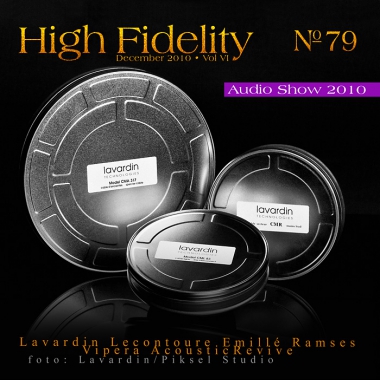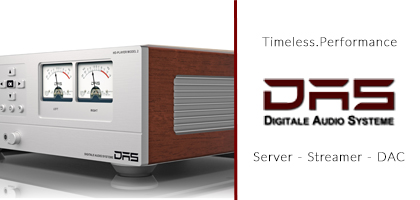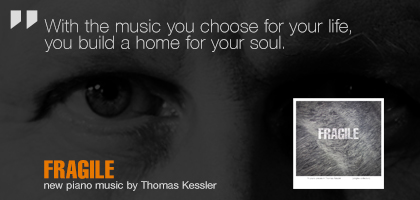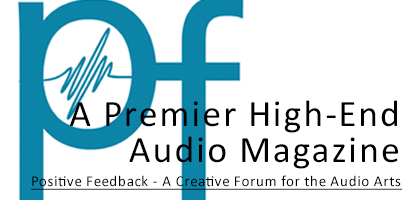 Contents
Contents
No. 257 October 2025
- COVER REVIEW: ANCIENT AUDIO Silver Grand Mono Mk II ⸜ power amplifier • monoblocks » POLAND • Kraków
- KRAKOW SONIC SOCIETY № 153: 30 years of ANCIENT AUDIO » POLAND • Kraków
- FEATURE ⸜ music & technology: HISAO NATSUME presents - In search for the lost great pianism Chopin tradition » part 2 (France) » JAPAN • Tokyo
- REVIEW: AUDIOPHONIQUE Classic AP 300D ⸜ power amplifier » POLAND • Pruszków
- REVIEW: AVATAR AUDIO Holophony No. 1 ⸜ loudspeakers • floor-standing » POLAND • Osowicze
- REVIEW: DIVALDI Gold PA One ⸜ integrated amplifier » POLAND • Kraków
- REVIEW: J.SIKORA Aspire ⸜ turntable (deck + tonearm) » POLAND • Lublin
- REVIEW: MB AUDIO CABLE Silver ⸜ analog interconnect ⸜ RCA » POLAND • Turza Śląska
- REVIEW: XACT N1 ⸜ LAN switch » POLAND • Wrocław


|
SDMusA – (Finally) A digital revolution?

I try not to give my columns grandly sounding titles. Titles like “The best…”, “A breakthrough in…”, “The winner…”, etc, make me laugh. Unfortunately such titles are overused by “Stereophile”, one of the most important titles in the world. Because a breakthrough is something, that by definition happens rarely, and has significant impact on everything. And most audio products are usually only “improvements”, “bettering”, “new approaches”, “interesting approaches”, and similar. But this time we might be witnessing something that may – but does not have to – change the audio world. I am talking about SDMusA. This is a joint project of Mr. Jarek Waszczyszyn (Ancient Audio) and Mr. John Tu, the owner of one of the biggest flash memory manufacturers in the world (a few words about both gentlemen can be found HERE). They both say, that this is more their private initiative, not necessarily related to their companies, but those relationships cannot be eliminated at a deeper level. But the most important thing is, that the foundation for this idea was their passion, and not really the intention to make profit. IntroductionWhat is SDMusA? This is a multimedia platform, using three elements: a player, a carrier and content. The most important information is about the carrier – this is a physical one, a flash memory card of the SD (Secure Digital) standard. It can be played on any kind of player, starting from mobile phones to hi-end players. The music will be recorded in high resolution. The second important aspect is, that the interactive element is to be very worked out – I mean films, biographies, etc. The third important thing is, that such discs will be able to be recorded over the internet. And all of that having a high degree of protection against piracy. This concept is not new, because Linn and Naim, not even mentioning others, promote media players for a few years now. And here we can see the first signs of the brilliance of SDMusA. This is not a hard disk based platform, which have their problems, but bases on a much better flash technology. And it is not only audio, but also video. And what is most important for the audiophile: the player does not need any processors or other complicated solutions! This is not a specialized computer! In the player I will tell you about in a few moments, Mr. Waszczyszyn used a single FPGA chip to handle data flow. DescriptionThe details will be presented by Mr. Waszczyszyn, co-creator of SDMusA: “SDMusA was created as a solution to the most grave problems of the current multimedia market: SDMusA is : 1. One album will be played with 100% compatibility on all devices, with the highest quality available. The quality of the sound is limited by the player and not the recording. 
2. Simple to use. All devices will be handled in the same way. All albums will have identical navigation. 

3. Lower price. The highest cost of a CD, DVD or Blu-ray is the cost of distribution. Because SDMusA albums will be distributed by internet, those costs will fall off. The recordings will be able to reach the buyers directly from the performer, or producer. 4. The owner of legally recorded albums will have free access to extra content, like live versions, interviews, photos or concert tickets. 5. The music and film market will be more diversified. Low costs, small investments and quick distribution will be available also for small labels. Even a single artist will be able to distribute his recordings in the whole world – and make money with that. It will stimulate the growth of new talents (and maybe replace in time Diana Krall, Sara K, or Ozzy Osbourne…) 6. SDMusA has the biggest possibilities from all the solutions listed: And what will be in it for the show business? Limitation of piracy, additional income from enhanced re-editions of older material, a common platform for music and film, low distribution costs and a new channel for promotion and marketing. The first album released in this new technology will be A Story of Polish Jazz from Jarek Śmietana. A few copies will be given out during the Audio Show… On November 1st a web page with a detailed description, links to software and demo albums will be presented. Jarek Śmietana agreed to have 20-second samples of his recordings published.” 
Yes, it sounds fine… But because in “High Fidelity” and “Audio” I taken on the topic of file players (hard disk players, memory card players, servers – there are many names), I immediately came up with some questions. Because what is the actual difference from simple downloading from the Internet? We have a few answers in the text above - we have a player without an operating system, without a computer, and we have pictures on the card, that can be played on any possible player. Anyway I kept on digging. Those are not all my doubts, I will get back to them on a later date (this is only an introduction to the technology), but I mentioned a few in my correspondence with Mr. Jarek: |
Jarek Waszczyszyn: Thank you for such a quick reaction, Mr. Wojciech! The situation with the presentation is not so typical, because the project is not fully finished. We present the first phase – however it is most interesting for the user. The completed system will not have to be presented on a show – everyone will have it at home… But this is how you do it – for example Windows 7 had a few official presentations before it was ready for sale. Sometimes research work is being show, about which we know, that they will not make it into a product. We will present the unprotected version, just to show the users, how the whole will look. Wojciech Pacuła: How exactly does the CPRM work – is it similar to Digital Rights Management (DRM)? If yes, then it will be a step backwards. Two years ago all labels ceased to use it, because it prevented from transferring it between two devices at home, what undermined the whole idea of digital distribution. JW: The description of CPRM is HERE. DRM is a software to protect the work of another software. That is not good. Sending a file from one device to another, also the DRM software was transferred. And it worked differently on different platforms, and sooner or later it would hang. It had to oversee the hardware, and the hardware was always different. Breaking the protection is easy, and the whole usage is very cumbersome, because you have to check each time, if the file is legal. It takes so much time, that there is none over for playing… CRPM on an SD card is something different. First of all, this is hardware, a small controller, mounted on EACH SD card. It is responsible for the protection. It has a hidden part of the memory, not accessible for the user. There is a lot of data hidden there, for example the manufacturer codes, serial number and data for the random generator. To access that memory you need a key. And the card generates the key using the random generator. So there is no connection between the serial number and the key code. And here is the asset of using a physical carrier as compared to file sharing. This is similar to hardware keys for certain software. The software does not run, if it does not have the key. It can be copied many times over, but it will only be able to run, when you have the key. Here it is similar, with the exception, that the files and the key, are on the same card. It can also turn out, that the unprotected version is also attractive, similar to the already existing sales of MP3 or FLAC files. The decision will be with film and music producers. Besides the protection, SDMusA is a very nice and universal multimedia file organizer. This feature can be used – something like landing on the moon, from which we use Teflon and Velcro… WP: Who owns the patent? With whom any agreements were signed, or talks are being conducted?/p> JW: The project will be finances from John’s private money. The owner of the patents, name, domains and all intellectual values are me and John, as private persons. We talk with many small labels, with some we are already finishing negotiations. The larger ones will come later. WP: Are there any, even very basic, simulations regarding the pricing? JW: Yes, please look below: 
WP: Do you know already, which of the large internet distribution companies (like for example HD Tracks) will offer something like that? JW: There is no decision yet, but some small companies already showed interest. This is where the revolution will start, because for the small companies, distribution is the bottleneck. Even if the large companies will not be interested at first, they will join later. This like YouTube or Facebook. WP: Now the most important thing: while music will be distributed over the internet, where is the difference from what Linn does today? If the whole operation is related to the physical carrier, the SD card, then I understand. But if this is to be distributed over the net, then I do not understand anything :) JW: System Linn or HD Tracks is a niche. This is only music and sometimes a small cover. Addressed to audiophiles, it does not have any kind of protection. And most important, there is no thought through standard of navigation and usage on other platforms. That is why it always will remain a niche. On the other hand SDMusA is a complex solution, and universal enough, to become a widely accepted one. It integrates music, film, books, instructions, other things for the mobile phones (this may sound weird, but this IS the mass user), but also for the big screen and audio hi-end systems. If somebody will buy a new album of the L'Arpegiatta, then it can be listened to on the mobile phone (it sounds quite well that way) and later on a super player. And when new additional recordings, photos, interviews become available, then it will be easy to add them to the already owned ones… And now the SD card and Internet. The SD (and Micro SD) is the most versatile carrier. The popular pendrives do not fit in the mobile phones, and they have no protection. Albums recorded on the card will be able to be bought in the shop (as a present for example…), but recording the card at home will be the basic option. This is the only way to keep them cheap. The prices of the carriers fall – an 8GB card (suitable for 8 typical albums) costs around 50 zl, so it is about 6.25 per album. And it will be cheaper. Of course the retail price of the albums will depend on its producer. Every download may be encrypted with a key of a certain card. The cracking of a key to one card will not be sufficient, because another card will have a completely different one (this is why they have an internal random generator, and a hardware one, at that – it cannot be peeked at, like a software one could be). And finally some legal aspects. How to prove to someone, that he owns the file illegally? A file is just information, and an SD card is something physical, and well signed. We can check, who manufactured it, when it was sold and to whom, when someone recorded it and from whom. Another advantage is the transfer of recordings. Transferring files is very troublesome, I know, I tried it. Audio is quite OK, but transferring a 5 minutes video to a mobile phone took an hour. Someone transferred the film Mamma Mia! from DVD to a mobile phone 16 hours. And he used a fast computer. Please imagine the Audio Show, where somebody wants to listen to his favorite file… There is no way to legally borrow a file. We can only copy it. Legally (erasing the file at home, and then the lender must delete it when returning) is hard, and illegally it is a very common behavior (official data talks about 95% of piracy in the USA. Worldwide it is 99.99999999 %...). The world needs a carrier. Interestingly, no one really cares about that – we talked to one of the bosses of the Fraunhofer Institute (the inventor of MP3, MP4). He claims, that the Blu-ray is the last carrier. We will see… For now, the role of the new, protected carrier, was taken by the iPod or iPhone and iTunes. It can be carried from the bedroom to the car, and not the files with the recordings! But this is not good – this is not the goal it was created for. SDMusA Player Ancient Audio WP: I would also like to hear a few words about your player – any details? SDMusA Player is a prototype to present and verify the quality of the sound from the card. But it turned out to be so good, that after some improvements it will be the final product, aimed at audiophiles, recording studios, etc. 
- sound (2 channels, 16-24 bits, 44.1; 48; 88.2; 96; 176.4; 192 kHz), The whole is based on dedicated hardware, built on a FPGA. There is no operating system, or a main processor (there are a few small ones, handling the display, the keypad, etc). To minimize distortion the whole player is clocked with one of two clocks, depending on the fact, if the recording is a multiplication of 44.1 or 48kHz. One clock serves the readout and DAC. The readout of the data, and especially sending it to the DAC, is handled by a logic chip, and not a processor. This is a unique solution. This is why there is no distortion or jitter./p> The audio part is a derivative from the Lektors. After modification it was also used in the Lektor Air. So there are analog volume controls, V-caps and tubes. PremiereI will say it that way: I am the first journalist in the world, who saw the mentioned player, listened to it and learned about this unique technology. The meeting happened on June 6th, 2010. This was an unofficial presentation of the SDMusA, but I could not disclose it earlier. Usually I do not participate in presentation with a non-disclosure clause. But this time this was a very unique thing for me, and I could not do otherwise – I hope you can forgive me. How does it sound? Very well, but I need to listen to it in my system, at home. If everything goes well, the SDMusA player will have its world premiere in “High Fidelity”. Ancient Audio 
Wojciech Pacuła |
||||||||
|
|||||||||
About Us |
We cooperate |
Patrons |
|
Our reviewers regularly contribute to “Enjoy the Music.com”, “Positive-Feedback.com”, “HiFiStatement.net” and “Hi-Fi Choice & Home Cinema. Edycja Polska” . "High Fidelity" is a monthly magazine dedicated to high quality sound. It has been published since May 1st, 2004. Up until October 2008, the magazine was called "High Fidelity OnLine", but since November 2008 it has been registered under the new title. "High Fidelity" is an online magazine, i.e. it is only published on the web. For the last few years it has been published both in Polish and in English. Thanks to our English section, the magazine has now a worldwide reach - statistics show that we have readers from almost every country in the world. Once a year, we prepare a printed edition of one of reviews published online. This unique, limited collector's edition is given to the visitors of the Audio Show in Warsaw, Poland, held in November of each year. For years, "High Fidelity" has been cooperating with other audio magazines, including “Enjoy the Music.com” and “Positive-Feedback.com” in the U.S. and “HiFiStatement.net” in Germany. Our reviews have also been published by “6moons.com”. You can contact any of our contributors by clicking his email address on our CONTACT page. |
 



|
   |
main page | archive | contact | kts
© 2009 HighFidelity, design by PikselStudio,
projektowanie stron www: Indecity
















